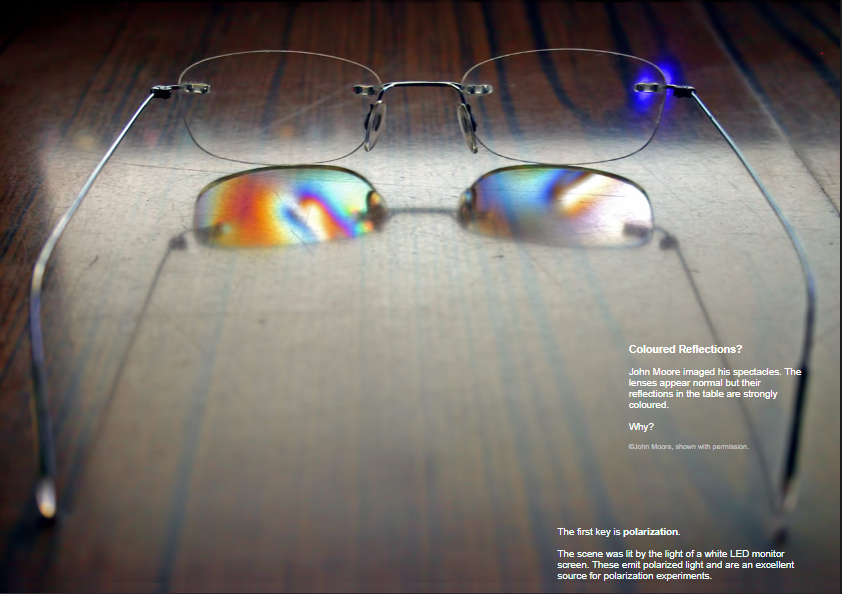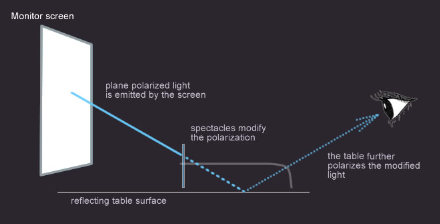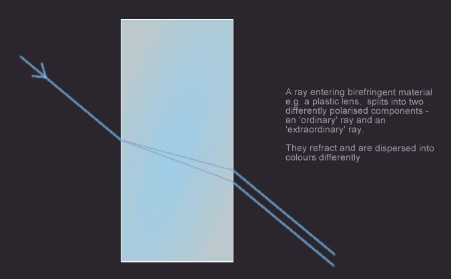OPOD - Coloured Reflections?
OPOD - Coloured Reflections: A Deeper Look into the Phenomenon
Have you ever noticed that sometimes the reflections in your spectacles appear to be strongly colored? This intriguing optical phenomenon has caught the attention of many, including photographer John Moore. In his images, the lenses of his spectacles appear normal, but their reflections on the table exhibit vibrant colors. But why does this happen? Let's delve into the science behind these colored reflections and explore the fascinating factors at play.
The first key element in understanding this phenomenon is polarization. In Moore's case, the scene was illuminated by the light emitted from a white LED monitor screen. It is important to note that LED screens emit polarized light, making them ideal for polarization experiments. When this polarized light reflects off a non-metallic surface, such as the table, it becomes further polarized. The degree of polarization through reflection varies depending on the viewing angle.
You may be familiar with polarizing sunglasses, which are designed to suppress reflections and reduce polarized light. These sunglasses allow light that is polarized at right angles to that reflected by horizontal surfaces or water to pass through, effectively blocking or minimizing polarized light from reflections. However, in the case of colored reflections in spectacles, the presence of dual polarization alone is not sufficient to produce colors.
Another crucial factor contributing to colored reflections is birefringence. Certain materials, including plastic spectacle lenses, calcite, crystals, and even ice, exhibit birefringent properties. These materials are anisotropic, meaning their optical properties depend on the direction of light propagation.
In the simplest form of birefringence, incident light is split into two distinct rays that are polarized and refracted differently. These two rays also disperse colors differently. When the incoming light is first polarized and the emerging light is viewed through a second polarizer, color patches become visible. The colors observed arise from constructive and destructive interference between the two differently polarized rays.
Constructive interference occurs when the wave crests of the two rays are in phase, resulting in a bright color. Conversely, destructive interference leads to less or no light being observed. The phase condition for interference depends on the wavelength (color) and the viewing angle. As a result, we perceive patches of color in the reflections.
In the case of plastics, the colors observed are irregular due to the birefringence generated during the extrusion and molding process. The extent and direction of anisotropy causing birefringence are a result of strains and molecular orientation that become frozen in as the plastic solidifies. To observe birefringence more clearly, it is best to illuminate the material with plane-polarized light and view or photograph it through a second polarizer. However, even without these specific conditions, the colors can still be seen, albeit with less intensity. This is evident when observing colors through aircraft windows.
The phenomenon of colored reflections in spectacles is a captivating example of how light interacts with different materials and surfaces. By understanding the principles of polarization and birefringence, we gain insights into the intricacies of this optical phenomenon. Next time you notice those vibrant hues in your spectacles' reflections, you'll have a deeper appreciation for the scientific wonders at play.

Coloured Reflections?
John Moore imaged his spectacles. The lenses appear normal but their reflections in the table are strongly coloured.
Why?
©John Moore, shown with permission.
The first key is polarization.
The scene was lit by the light of a white LED monitor screen. These emit polarized light and are an excellent source for polarization experiments.

The light was further polarized when it was reflected from the non-metallic surface of the table. The extent of polarization by reflection depends on the viewing angle.
Sunglasses are made of polarizing material to suppress reflections. They let through light polarized at right angles to that reflected by horizontal surfaces or water and so block or reduce the polarized light from reflections.
But the dual polarisation will not produce colours unless the spectacle lenses have particular properties.


Birefringence.
Some materials - plastic spectacle lenses, calcite and other crystals, ice - are birefringent. They are anisotropic and their optical properties are dependent on direction.
In the simplest type of birefringence light is split into two distinct rays which are polarised and refracted differently.
The two rays also have their colours dispersed differently and this becomes apparent when the incoming light is first polarised and the emerging light is viewed through a second polariser. We then see colour patches.
The colours arise from constructive and destructive interference between the two differently polarised rays. The two rays have slightly different optical path lengths as they traverse the plastic. On emerging, their wave crests can be in phase and combine to give a bright colour. They could also be out of phase giving less or no light. The phase condition depends on the wavelength (colour) and the viewing angle.
The result is patches of colour. In plastics the colours are irregular because the birefringence was generated when the plastic was extruded and moulded. The extent and direction of the anisotropy causing the birefringence is the result of strains and molecular orientation frozen in when the plastic solidified.
Birefringence is best seen by illuminating the material with plane polarized light and then viewing or photographing it through a second polarizer. The colours can be seen, but more weakly, without these strenuous conditions. The colours seen through aircraft windows are examples.
Note: this article has been automatically converted from the old site and may not appear as intended. You can find the original article here.
Reference Atmospheric Optics
If you use any of the definitions, information, or data presented on Atmospheric Optics, please copy the link or reference below to properly credit us as the reference source. Thank you!
-
<a href="https://atoptics.co.uk/blog/opod-coloured-reflections/">OPOD - Coloured Reflections?</a>
-
"OPOD - Coloured Reflections?". Atmospheric Optics. Accessed on December 22, 2024. https://atoptics.co.uk/blog/opod-coloured-reflections/.
-
"OPOD - Coloured Reflections?". Atmospheric Optics, https://atoptics.co.uk/blog/opod-coloured-reflections/. Accessed 22 December, 2024
-
OPOD - Coloured Reflections?. Atmospheric Optics. Retrieved from https://atoptics.co.uk/blog/opod-coloured-reflections/.